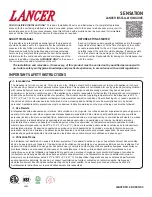
CHECK YOUR WATER PRESSURE AND PUMPING RATE:
Two water system conditions must be checked carefully to
avoid unsatisfactory operation or equipment damage:
1) MINIMUM water pressure required at the water softener
inlet is 20 psi (138 kPa). IF PRESSURE IS OVER 100
PSI (689 kPa), A PRESSURE REDUCING VALVE
MUST BE INSTALLED IN THE WATER SUPPLY LINE
AHEAD OF THE WATER SOFTENER.
NOTE:
If you have a municipal or a community water
supply and daytime water pressure is 85 psi (586 kPa)
or more, nighttime pressure may exceed 100 psi (689
kPa). Call your local water department or plant operator
to obtain pressure readings. If you have a private well,
the gauge on the pressure tank will indicate the high
and low system pressure. Record your water pressure
data below:
WATER PRESSURE
Low _______ psi High _______ psi
2) The pumping rate of your well pump must be sufficient
for satisfactory operation and BACKWASHING of the
WATER SOFTENER.
(see SPECIFICATIONS AND
OPERATING DATA , Section 5).
LOCATE WATER CONDITIONING EQUIPMENT CORRECTLY
Select the location of your water softener with care.
Various conditions which contribute to proper location are
as follows:
1) Locate as close as possible to water supply source.
2) Locate as close as possible to a floor or laundry tub
drain.
3) Locate in correct relationship to other water condition-
ing equipment (Figure 1).
4) Locate the softener in the supply line BEFORE the
water heater. Water temperatures above 100°F (38°C)
will damage the softener and void the factory warranty.
5) DO NOT install the softener in a location where freezing
temperatures occur. Freezing may cause permanent
damage and will also void the factory warranty.
6) Allow sufficient space around the unit for easy servic-
ing.
7) Provide a non-switched 110/120V, 60Hz power source
for the control.
FACTS TO REMEMBER WHILE PLANNING YOUR IN-
STALLATION:
(1) All installation procedures MUST conform to local and
state plumbing codes.
(2) If lawn sprinkling, a swimming pool, or geothermal
heating/cooling or water for other devices/activities are
to be treated by the water softener, a larger model MUST
be selected to accommodate the higher flow rate and
softening demand of these items. The pumping rate of
the well pump must be sufficient to accommodate these
items plus the backwashing requirements of the water
softener. Consult your dealer for alternative instructions
if the pumping rate is insufficient.
(3) Remember that the water softener INLET is attached to
the pipe that supplies water (i.e., runs to the pump), and
the OUTLET is the line that runs toward the water heater.
(4) Before commencing the installation it is advisable to
study the existing piping system and to determine the
size, number and type of fittings required.
NOTE: If the plumbing system is used as the ground leg
of the electrical supply, continuity should be maintained
by installing ground straps around any nonconductive
plastic piping used in installation.
(5) It is also advisable to sweep the floor to eliminate
objects that could pierce the brine tank.
(6)
SODIUM INFORMATION:
Water softeners utilizing
sodium chloride for regeneration add sodium to the
water softened water. Persons who are on sodium
restricted diets should consider the added sodium as
part of their overall sodium intake. As a reference as to
how much sodium is added to softened water consider
the following. For each grain per gallon of water hard-
ness that is exchanged from the water supply, 7.5 milli-
grams per liter of sodium will be added to the softened
water. e.g. 10 grains per gallon (gpg) exchanged will
add 75 milligrams of sodium to the softened water.
1-2
CAUTION
To reduce the risk associated with property
damage due to water leakage:
x
Do not install on systems where line
pressures above 100 psi (689 kPa) may
occur.
CAUTION
To reduce the risk associated with property
damage due to water leakage:
x
Do not install system where water lines that
could be subjected to a vacuum condition
without appropriate measures for vacuum
prevention.
The installer should take appropriate measures if there is
the possibility a vacuum may occur. This would include
the installation of an appropriate device in the supply line
to the system, i.e., a vacuum breaker or backflow
prevention device. Vacuum damage voids the factory
warranty.
WARNING
To reduce the risk associated with ingestion of
contaminates due to use with water that is
microbiologically unsafe or of unknown quality:
x
Do not use with water that is microbiologically
unsafe or of unknown quality without
adequate disinfection before or after the
system.
IMPORTANT NOTE





































